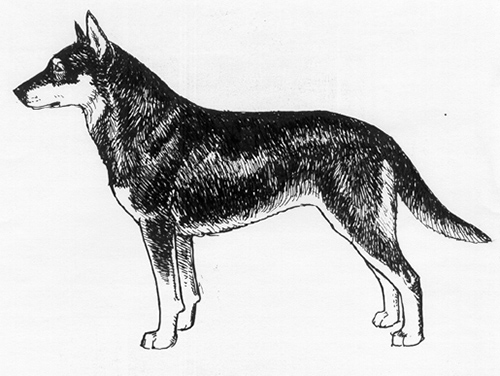Lapinporokoira (Lapponian Herder)
Herding Dog Group
The goals and purposes of this breed standard include: to furnish guidelines for breeders who wish to maintain the quality of their breed and to improve it; to advance this breed to a state of similarity throughout the world; and to act as a guide for judges.
Breeders and judges have the responsibility to avoid any conditions or exaggerations that are detrimental to the health, welfare, essence and soundness of this breed, and must take the responsibility to see that these are not perpetuated.
Any departure from the following should be considered a fault, and the seriousness with which the fault should be regarded should be in exact proportion to its degree and its effect upon the health and welfare of the dog and on the dog’s ability to perform its traditional work.
History
The Lapponian Herder originated in Finland, where for hundreds of years the Lapps have used dogs of this sort for herding reindeer. Once grouped together as a breed with the Finnish Lapphund, the Lapponian Herder was separated into its own breed in 1966.
The Lapponian Herder was recognized by the United Kennel Club July 1, 2006.
General Appearance
A medium-sized, spitz-like breed, clearly longer than tall, with strong but not heavy bone and musculature, and a coat that withstands the arctic climate. The sex of the dog should be readily apparent by visual examination.
Characteristics
Docile, calm, friendly, energetic and willing to work, the Lapponian Herder barks freely when working.
Head
Typical spitz type head, with the muzzle shorter than the skull and a sloping stop.
SKULL
Slightly convex, with a marked frontal furrow and the superciliary ridges clearly defined.
MUZZLE
Tapers evenly from the eyes to the nose. The nasal bridge is straight and the lips are tight.
TEETH
The Lapponian Herder has a complete set of evenly spaced, white teeth meeting in a scissors bite.
Disqualification: Overshot or undershot bite.
NOSE
Preferably black but may harmonize with the color of the coat in dogs that are other than black.
EYES
Set rather well apart, oval in shape and dark in color, harmonizing with coat color. Expression is keen and lively, and in females, devoted.
EARS
Set well apart, broad at the base, tapering to the tips and carried erect. The inside of the ears is furnished with thick hair.
Disqualification: Dropped ears.
Neck
Strong, medium length, blending smoothly into the shoulders.
Forequarters
Muscular and well angulated.
FORELEGS
Straight and parallel when viewed from the front. The elbows are close to the body, and the carpus is sinewy and flexible. The pasterns are slightly oblique, allowing for flexible movement. Leg length from elbow to ground is half the height at the withers.
Body
Longer than tall by 10 percent. The withers are marked, and the chest is deep and spacious, but not broad. The ribs are well sprung. The back is strong and muscular, the loin short and strong, and the croup is rather long and slightly sloping. The underline is gently tucked up.
Hindquarters
Well angulated, with rather long and broad thighs and strong muscles.
HIND LEGS
Straight and parallel when viewed from behind. Marked angulation at the stifle and the hock, which is well let down. Rear pasterns are short and vertical.
Feet
Oval, with well-arched toes and thick pads, and a heavy covering of hair, including on the bottom.
Tail
Medium in length, set low, and profusely coated. In repose, the tail hangs down. In movement, it is carried in a loose curl, but may not be raised over the back. The tail action may be circular.
Coat
Double, with the outer coat fairly long, straight, harsh and erect. The undercoat is fine and dense. The hair is often more profuse on the neck, chest and back of the thighs.
Color
Black, gray or dark brown, with lighter shadings. White markings on the neck, chest and legs are permitted. The undercoat is black, grayish or brownish.
Height and Weight
Ideal height for males is 20 inches, for females it is 18 inches. There is an allowable tolerance of 1 inch over or under the ideal.
Gait
Free, flexible and effortless, giving the appearance of being tireless. At faster speed there is a tendency to single track.
Disqualifications
(A dog with a Disqualification must not be considered for placement in a conformation event, and must be reported to UKC.)
Unilateral or bilateral cryptorchid.
Viciousness or extreme shyness.
Albinism.
Overshot or undershot bite.
Dropped ears.

Looking for a Dog?
Find a dog that will fit your family.
Note: The breeders on this list are not endorsed by UKC.
©Copyright 2006, United Kennel Club
